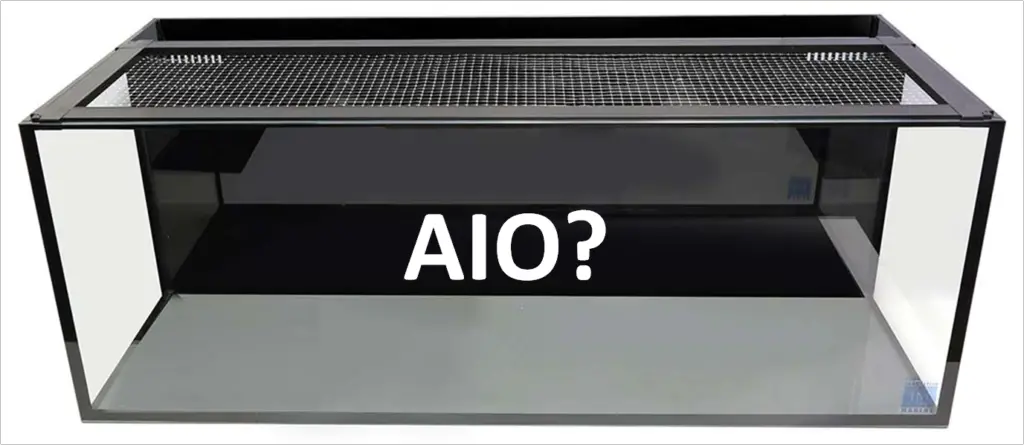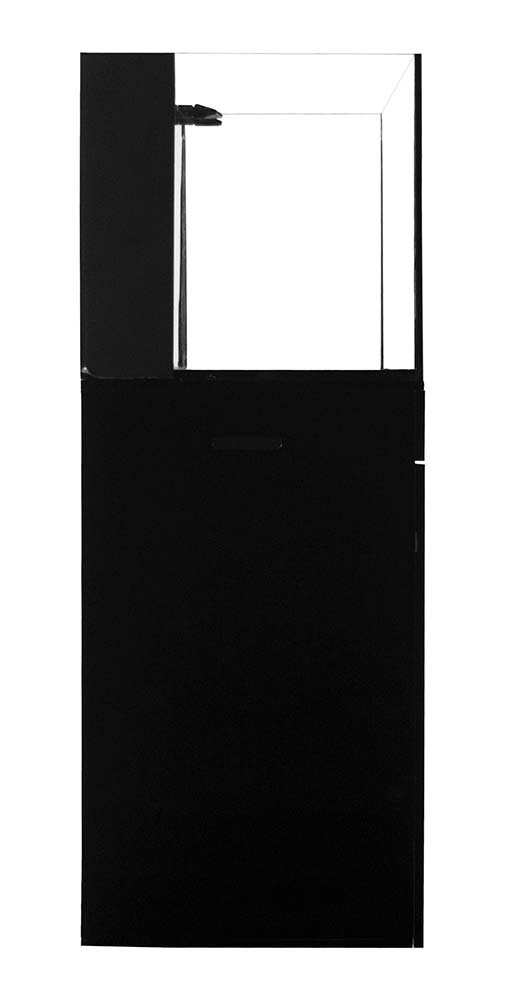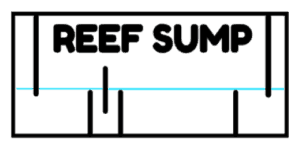
Saltwater aquariums on the surface can be pretty intimidating with a myriad of equipment including protein skimmers, media reactors, pumps, and powerheads. Throw on top of that a sump, plumbing, filter socks, and dosing the complexity continues to increase even before getting to water chemistry, livestock, and coral. With all this in mind, it may just be enough of a barrier to keep a person out of a wonderful hobby.
What if you could bypass a lot of the equipment decision paralysis simply get a package that has everything you need to be included? Now you can with an all-in-one saltwater aquarium. An all-in-one saltwater aquarium is an aquarium that comes with everything you need to for a starter saltwater aquarium. All-in-one aquariums typically have a section on the back of the tank where all of the filtration and equipment are housed removing the need for you to have a sump or other hang on the back type equipment.
All in one aquariums abbreviated as AIO have become increasingly popular in recent years and there are many nice options available on the market.
In this article, we’ll explore all in one saltwater aquariums and why or why not they may be right for you.
Red Sea Max Nano Aquarium, 20 Gallon
This system provides everything necessary in order to enable you to enjoy the beauty and diversity of your own piece of thriving coral reef, rather than worrying about component selection, suitability and compatibility
How Does an All in One Saltwater Aquarium Work
All-in-one saltwater tanks usually work by draining the display tank’s water into a separate section in the back of the tank out of the view of the display.
This back section of the tank is separated into chambers with each chamber dedicated to a function for supporting the aquarium. Sections can include mechanical filtration, chemical filtration, protein skimming, returning water to the display tank, and in some configurations even a refugium section.

Some all-in-one tanks have sections that can be customized based on how a reefer likes to set up their system.
Each all-in-one tank will have different options and functions but most follow the same process for filtering the tank’s water. Dissolved organic waste often collects on the surface of a display tank’s water. To rid the tank of this organic waste, an all-in-one tank will surface skim the top of the water draining it through a weir into the filtration area in the back of the tank. As the water drains into the back of the tank its first stop is usually mechanical filtration in the form of a filter sock or other filter type material. The water will continue along to the next section which might be a heater section to heat the water. The next section might include chemical filtration. Many all-in-one configurations include media baskets allowing you to fill the basket with different chemical media depending on what a tank needs or a reefer prefers. The next section might include a protein skimmer that very efficiently removes dissolved organic waste from the water column. In the last section, the water is returned to the display tank via a return pump.
ReefSumper Recommended Protein Skimmers
In addition to the filtration system, some all-in-one tanks will come with lights and a stand.
What Other Equipment Will I Need to Get With an All in One System
A good all-in-one system will come with everything you need to get a saltwater tank up and running out of the box, but with so many options on the market, this depends on the all-in-one aquarium that you choose. Some common pieces that I see with all-in-one aquariums are that they often do not come with a heater. If this is the case you’ll want to buy a heater that is appropriately sized for you all in one tank and fits in the section where you want to keep it. A good rule of thumb is 1 watt per gallon of water in your system. This will vary depending on how warm you keep your house especially in winter. You will also need a stand and lights if the all-in-one tank doesn’t include them.
ReefSumper Recommended Heaters
ReefSumper Recommended Powerheads
Outside of those items, you may want to upgrade some of the equipment or capabilities of your all-in-one system. Most all-in-one tanks only include the return pump and depending on the livestock and coral you want to keep, you may want to increase flow by adding an additional powerhead.
Advantages of All in One Saltwater Aquariums
- Includes everything in an all in one package to get you up and running with limited research into each piece of equipment. With everything ready to go for you this can be a real time saver.
- A good all in one system is designed and engineered to work beautifully together. Some of the most aesthetically pleasing tanks are all in ones.
- The equipment is well hidden in the back of the tank and can be a real space saver. These tanks can usually be pushed right up to the back of a wall.
- One of the biggest advantages of all in one tanks is cost. With everything included these can be offered at a lower price point than pricing out each component of a reef aquarium.
Disadvantages of All in One Saltwater Aquariums
- The biggest disadvantage, in my opinion, is the loss of reef keeping leveling up. An all in one tank is just easier to set up than taking a blank slate aquarium and designing, researching, building, and tweaking to your heart’s desire.
- I find much more satisfaction with my tank over the long run when I pieced it out and put together including activities like drilling and plumbing. When I built my 75-gallon tank I learned an immense amount of skills in reef keeping and general handyman type skills.
- Customization is often limited to all in one setups. You are limited to the space of the filtration area and what is made for the tank and what could fit.
- You might be at the mercy of the manufacturer. If a piece of the system breaks it could be hard getting a replacement especially if they’ve stopped making the system. You’d be left with trying to retrofit a solution.
Are All in One Saltwater Aquariums Worth it
If you are looking for a quick lower-cost entry to the saltwater aquarium hobby, an AIO system would be a good way to go and could be worth it. AIO’s can be the ultimate option for a beginner just getting into the hobby. Having to wade through the minutia of equipment available and getting it all tied together can be a daunting task to a novice. AIO allows cutting through this and set up a fully functioning aquarium right out of the box. Not having to worry about the initial system, there is plenty enough to learn about including cycling, maintenance, and livestock considerations.
With that said, one of the most common things I see with reefers including myself is the continuous progression into a larger or more elaborate reef tank setup. I would recommend taking a slower approach in planning your first or next reef tank. Pick the perfect spot for your reef tank and then build around the location by picking the tank size that will fit perfectly for the location. If you decide to go with an AIO choose the largest tank that will fit the spot and has as much customization as possible. I find that new cool equipment comes on the market all the time and having an open spot for equipment like in a sump the options to customize and upgrade sump equipment is a necessity in the hobby. Regardless of a custom sump style tank or an AIO, I don’t think you can go wrong if it gets you into the hobby.
JBJ Rimless Flat Panel 45 Gallon Black Aquarium, Stand, & Kessil A360X Tuna Blue LED Light Bundle
The JBJ Rimless Flat Panel 45 Gallon Black Aquarium & Stand bring together simplicity and elegance. Their all-in-one design makes equipment selection and setup a breeze.


